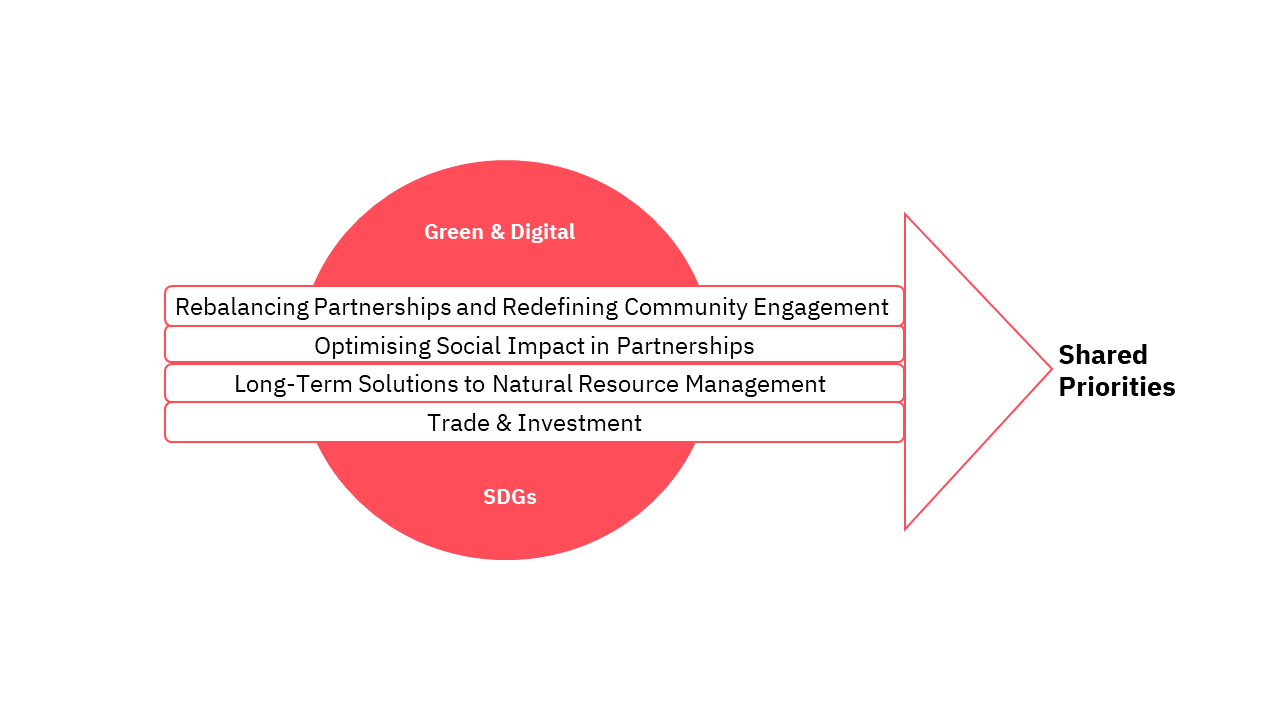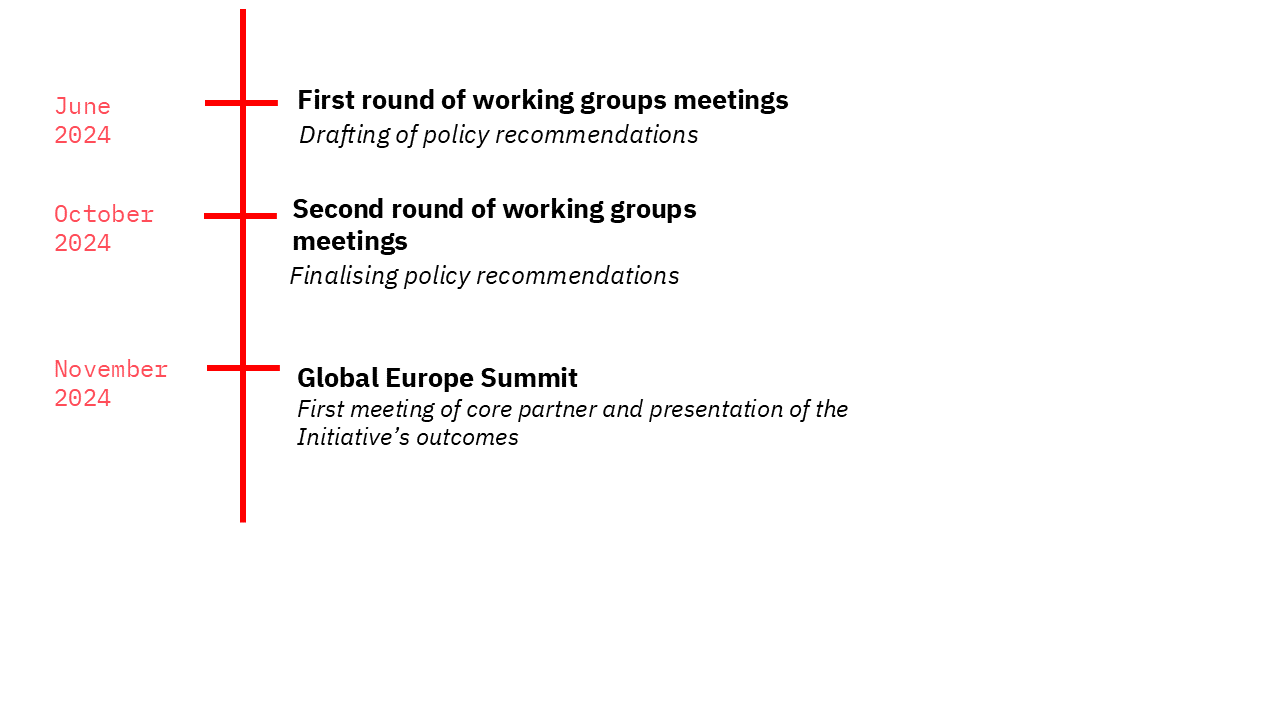Europe-China Forum: 20 years on – what’s next for EU-China relations?
Past event HYBRID & LIVESTREAM

- Area of Expertise
- Global Europe
Initiative
Development, Resources, Infrastructure, Vision, Exchange


We live in chaotic times. Climate change and digitalisation are the latest lightning rods of our current and future societies and will unevenly impact communities, reflecting the structural inequalities across the world and giving rise to a new nexus of trade, development and security. Has development aid achieved sustainable impact and improved conditions for economic growth? Are there indicators to determine how livelihoods have been improved?
As the European Union rolls out its Global Gateway and related investment plans, it is important to consider how the EU’s target regions and partners perceive and engage with the strategy, as well as other global development and investment frameworks. Successful investment and cooperation should not only effectively address global challenges, such as climate change, but also lead to meaningful progress towards the 17 United Nations Sustainable Development Goals (SDGs).
In recent years, countries have increasingly questioned the self-promotion of the EU as a role model of values. Development agencies, NGOs and regional actors receive financial means for their projects without concrete guidelines on how to spend the money in a way that is most beneficial to the country or region of implementation. Moreover, the private sector does not receive the necessary support and guidance to play a more active role in sustainable investments. This needs to change.
The DRIVE Impact initiative intends to expand and deepen the global and European conversation on sustainable and inclusive development by reimagining investment, funding, collaboration and impact evaluation.
The initiative’s starting point is to rethink conversations around aid, trade and sustainable development, as well as received wisdom and norms that have shaped funding approaches over the past 60 years, with the aim of learning from past mistakes and creating meaningful collaborative dialogue and practices among funders, investors, delivery and implementation bodies, the private sector, regional and local governance, and civil society organisations. DRIVE serves as the platform and catalyst for these actors to share knowledge and learning; discuss dilemmas, constraints and practice issues in a safe space; as well as improve the cycle of funding policy, delivery and importantly include a funding recipient perspective.
The intended outcomes are:
Ultimately, the goal is greater stability, sustainability and preparedness of people, communities and regions for the challenges of an increasingly unpredictable world.
The DRIVE Impact initiative encourages fresh thinking on issues and mechanisms, such as the European Global Gateway, community and social dividends for funding programme policy and evaluation criteria, the role of SDGs in partner agreements, the engagement of the (local) private sector, the upscaling of existing projects and solutions and, above all, shared priorities and truly equal partnerships.
The DRIVE Impact initiative is based on four thematic pillars, underpinned by a local and regional focus.

1. Rebalancing partnerships and redefining community engagement
This first pillar re-defines the term ‘partnership’ to ensure that future global partnerships will focus on shared priorities as well as concerns and conditions of partner regions. This means creating the opportunity for equal and open dialogue between local actors and EU representatives, which will require listening and engaging differently and better to and with those who are intended to benefit from funding, as well as other funders, and improving intra-institutional dialogue to reduce thinking in silos. This pillar also encourages and inspires an innovation mindset to funding and understanding impact.
2. Optimising social impact in partnerships
This pillar explores how to ensure community impact and community return on investment locally and regionally. Commissioning can significantly impact the purpose and use of investment and funding, proving to be transformative in terms of metrics and outcomes.
Positive social impact requires listening to local actors, identifying and responding to needs and being creative about embedding, enhancing and accelerating solutions. As climate change and digitalisation define the current social transition, it is essential to think about how infrastructure and community impact go hand in hand. In this context, social clauses should be factored into commissioning and funding processes by the EU, development banks and other actors through community dividends. Although successfully trialled across many governments in the world, such clauses have relied on the individual foresight and thoughtful leadership, as opposed to being a standard pre-requisite to enhance social and economic development. The community and social dividends that sit alongside large infrastructure projects can involve, for example, local labour development, increased housing stock, access to finance for entrepreneurs, community facilities or, on occasion, education. The return on the social impact of such mechanisms can be vast.
3. Long-Term Solutions to Natural Resource Management
Our global landscape is widely characterised by a skewed allocation of natural resources – certain regions or populations are disproportionately benefiting from their exploitation, while others are left marginalized and deprived. This inequity is a deeply entrenched structural issue that demands long-term solutions.
This structural inequity, however, can also be exacerbated by an escalating demand for natural resources, their hindered supply, and their limited accessibility. In fact, the world is now facing an increasing demand of natural resources, fuelled by population growth and an urgent need for green transition materials. Environmental degradation and climate change are also shrinking the pool of available resources. At the same time, the accessibility of natural resources is also highly dependent on international trade, which are heavily influenced by conflicts, elections, and other geopolitical factors.
To tackle this inequity, it becomes essential to define a new form of natural resources management – one that is conducted in an environmentally and socially sustainable way. This third pillar thus investigates ways to create resilient supply chains and communities, defining long-term solutions that allow this new system of natural resource management to take place.
4. Trade and investment
Reshaping procurement approaches can be a game-changer in multiplying wider community and social benefits. They serve as a platform for the private sector to define guidance and guarantee mechanisms together with the EU and development banks in order to de-risk private sector contributions by creating a more enabling environment for sustainable investments. Initiatives such as the European Global Gateway should provide a structured and coherent approach to achieving measurable change on the ground through better coordination, alignment and collaboration amongst funders and the (local) private sector. Additionally, this pillar examines, redefines and extends existing guidelines for the involvement of the private sector in partner regions, particularly relating to the upscaling of existing projects.
The DRIVE Impact initiative will be driven by its network of representatives from both EU and non-EU institutions, governments, the private sector including SMEs in project regions, development agencies, NGOs, international organisations and academia.
The network will come together two to three times a year in small working groups of 15 to 20 people, facilitated by Friends of Europe, to focus on one of the initiative’s four pillars. At the end of each year, a wider meeting is held for the whole DRIVE network to reflect on the progress made and set priorities for the coming year.

Past event HYBRID & LIVESTREAM

Past event In Person

Past event In Person

Past event Online & Livestream





We use cookies and similar technologies to adjust your preferences, analyze traffic and measure the effectiveness of our campaigns. Learn more about our privacy policy.